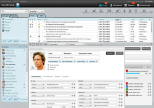Other items of interest (to me)
Collaboration
See my Web 3.0 = Collaboration blog.

The continued development in improved collaboration tools has the potential to make a big difference to the way we work, e.g. at some point it should be possible for knowledge workers to work as effectively from home as in the office. This page discusses some of the issues and provides an example "Collaboration Station" illustrating an implementation of techniques that might enhance productivity. At the heart of the design is an attempt to make the collaborative desktop 'person-centric' rather than 'tool-centric'.
Also more thoughts in my Collaboration notes.
Person-centric design

Product developers significantly underestimate the effectiveness of person-centric design, i.e. make it significant and meaningful to click on a person's name within the tool, taking the user to a display of information relevant in the context of that person.
I have illustrated how this approach would modify the UI of an email client, resulting in something I've called FaceMail.
Many systems would have 'person' as a useful additional primary noun. The main clue is when 'person' appears as an attribute of the thing the developer thought the system was about. For example eBay has 'item for sale' as the 'primary noun' (which appears to make sense, that's what eBay appears to be about) but each 'item for sale' has 'seller' as an attribute (i.e. person) and it is obvious (to me anyway) that a putative buyer of an item would want to click on the 'person' link and view a page about that person. Obviously that page would contain the feedback scores and the list of other 'items for sale' from that person. FWIW, eBay has gradually retrofitted this 'person' link/page into the system but even as of 2014 it is not as clear/consistent as their 'item for sale' page which is consistently displayed/linked wherever it appears. My use of the word obvious here is intended to be light-hearted, but it is my experience that if a 'person page' is considered within the development of a web-based system it it usually straightforward to derive some appropriate existing content to populate that page, as with eBay.
The key point is that people understand 'person' as a concept, so it makes a great primary noun in most systems. It will rarely be the most significant primary noun (the primary primary noun?) unless you're FaceBook, but counter-intuitively to some it is a good second choice popular with end-users.
Data-driven web design
The 'person-centric' approach referred in above is actually a special case of a general principle of data-driven web design: System designers should consider carefully the 'primary nouns' represented in their system and ensure an appropriate view page is available and consistently linked for each of those nouns.
This concept sounds simple, but has profound implications. The vast majority of web-based systems simplistically revolve around a single primary noun, e.g. a trouble-ticket system will only have 'trouble-ticket' as a primary noun (an apparent page will exist to display each trouble-ticket, and in most places where a reference to this ticket occurs a link will be provided to the corresponding page). But web-based systems always have sensible options for additional 'primary nouns' (e.g. in a trouble-ticket system a more important primary noun is 'person'). In this example the 'person page' contains links to that person's trouble-tickets, and the person's name on the trouble-ticket links to this person page.
The concepts involved have been summarized on my data-driven web design overview page.
Digital Cambridge
A plethora of online tools and systems are available to Cambridge staff and students. It is difficult to present a simple view of IT support in the university, including links for accessing these tools. The correct starting point is the UIS Homepage.
Where the IT solution is itself online, I've experimented with my Digital Cambridge page.
The general idea is the bottom-right link of each box is consistently a link directly to the service, the middle link will take you directly to setup information if that is appropriate (e.g. how to set up a desktop email client, or your wireless device), while the bottom-left link will be to more general support.
Systems design
I've created a draft page with some non-technical thoughts on issues of systems design.
Cloud computing
As of Nov 2010, many vendors are proposing 'cloud' computing solutions but there is a wide spectrum of techniques and technologies currently being touted, many of which are existing products and services re-branded to capitalize on the the current enthusiasm for the "cloud" label. I have created a basic web page illustrating the current cloud 'spectrum' complimenting a definition created by guys at NIST in the USA converted from Word to a web page by me.
